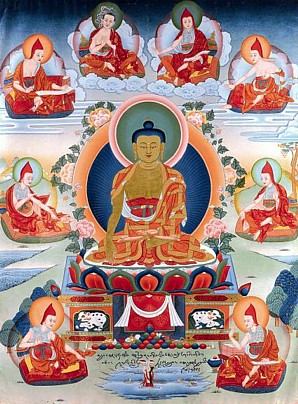Six Ornaments and Two Supreme Ones: Difference between revisions
Jump to navigation
Jump to search
No edit summary |
mNo edit summary |
||
| Line 1: | Line 1: | ||
[[Image:Buddha and 6 Ornaments 2 Supreme.jpg|frame|Buddha with the Six Ornaments and Two Supreme Ones]] | [[Image:Buddha and 6 Ornaments 2 Supreme.jpg|frame|Buddha with the Six Ornaments and Two Supreme Ones]] | ||
'''[[Six Ornaments]] and [[Two Supreme Ones]]''' ([[Wyl.]] ''rgyan drug mchog gnyis'') — great Indian commentators on the [[Buddha]]’s teachings. | '''[[Six Ornaments]] and [[Two Supreme Ones]]''' (Tib. རྒྱན་དྲུག་མཆོག་གཉིས་, [[Wyl.]] ''rgyan drug mchog gnyis'') — great Indian commentators on the [[Buddha]]’s teachings. | ||
==Six Ornaments== | ==Six Ornaments== | ||
Revision as of 14:27, 22 December 2010

Six Ornaments and Two Supreme Ones (Tib. རྒྱན་དྲུག་མཆོག་གཉིས་, Wyl. rgyan drug mchog gnyis) — great Indian commentators on the Buddha’s teachings.
Six Ornaments
Two Supreme Ones
1. According to one way of counting the Six Ornaments and Two Supreme Ones, this refers to
- Gunaprabha and
- Shakyaprabha.
2. According to another tradition, this refers to
- Nagarjuna, the founder of the tradition of Profound View and
- Asanga, the founder of the tradition of Vast Conduct.